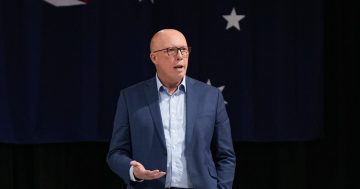
The PM won’t be calling an election anytime soon now that Queenslanders have had their say. Photo: AEC Images.
After the weekend’s election result in Queensland, it’s safe to say there won’t be a federal election this side of Christmas.
The next federal poll is due in May, and while Anthony Albanese has been consistent, when asked, in reminding everyone of that (with a smile on his face), speculation has continued to mount that the nation could be sent back to the ballot box by December.
Voters in Queensland put paid to that idea on Saturday.
There is no way for the Prime Minister to escape the fact he and his federal Labor team were handed a pretty strong message on the weekend.
Sure, there were plenty of state issues that influenced the outcome – including the ‘it’s time’ factor after a decade of Labor rule in the northern state.
But the bashing Steven Miles’ ALP government got at the hands of Queenslanders is more than a little worrying for the federal Labor machine.
The ALP is hoping to pick up federal seats in Queensland because it’s expecting to lose seats in other states.
If a federal election were held now, there’d be a greater chance of Labor picking up nothing more than a cold in the sunshine state.
Federal Treasurer Jim Chalmers gets it, even while trying to downplay the result’s significance.
“First of all, the outcome on Saturday night was decisive, but it wasn’t unexpected. And there are lessons for us, but there are also differences,” he said when asked about the implications for Labor federally.
“Theirs [Queensland Labor] was a government that had been there for almost a decade, ours is a government in its first term.
“There are obvious differences, but I don’t want to pretend that there aren’t lessons for us as well. Of course there are, there are always lessons in elections like this one.
“There are always things that we can learn, there are always things that we can do better, and we will go through the results with that in mind.
“We have always believed, and we have always acted in relation to this belief, that governments are always best when they govern for the whole place – the regions, the suburbs and the cities.”
That’s one of the interesting things about the Queensland result. It confirmed that people in the regions were after change, but they didn’t go to One Nation in the north as some suspected.
One Nation support fell in northern Queensland electorates, just as surprisingly as the Greens vote fell apart in inner city Brisbane.
Voters made a deliberate choice of the Liberal National Party over the Australian Labor Party.
The ALP did well in the state’s capital thanks to the collapse in the Greens vote.
Roy Morgan polling released on Monday (28 October) shows that if a federal election were held now, the result would be ‘too close to call’ with the ALP at 50.5 per cent (down 1.5% points from a week ago) just ahead of the Coalition at 49.5 per cent (up 1.5% points) on a two-party preferred basis.
It is a movement to the Coalition but not enough for it to govern in a majority.
Either the ALP or Coalition would require the support of minor parties and independents to form a minority government.
The polling preference flows show that the ALP primary vote dropped 2 per cent to 30 per cent, while Coalition support increased 1 per cent to 37.5 per cent.
Support for the Greens was up 0.5 per cent to 14 per cent and One Nation support was unchanged at 5.5 per cent.
Support for other parties was up 0.5 per cent to 4 per cent and support for Independents was unchanged at 9 per cent.
That’s how Roy Morgan polling sees it federally, and we know how Queensland voters see it at their state level.
The big question now is, how does the federal Labor Party see it all, and what changes is it going to make if it wants to get reelected – and keep governing – in the majority?





















